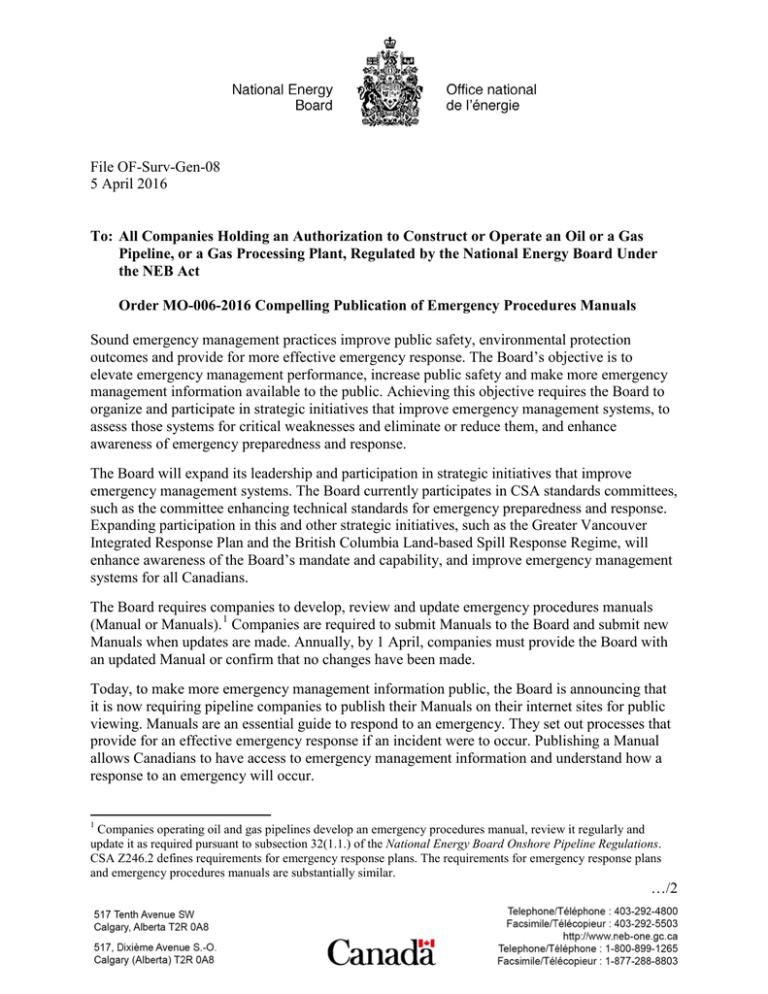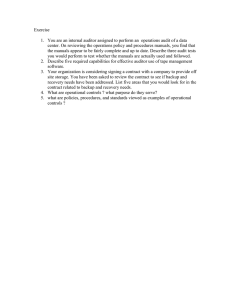Order MO-006-2016 Compelling Publication of Emergency
advertisement

File OF-Surv-Gen-08 5 April 2016 To: All Companies Holding an Authorization to Construct or Operate an Oil or a Gas Pipeline, or a Gas Processing Plant, Regulated by the National Energy Board Under the NEB Act Order MO-006-2016 Compelling Publication of Emergency Procedures Manuals Sound emergency management practices improve public safety, environmental protection outcomes and provide for more effective emergency response. The Board’s objective is to elevate emergency management performance, increase public safety and make more emergency management information available to the public. Achieving this objective requires the Board to organize and participate in strategic initiatives that improve emergency management systems, to assess those systems for critical weaknesses and eliminate or reduce them, and enhance awareness of emergency preparedness and response. The Board will expand its leadership and participation in strategic initiatives that improve emergency management systems. The Board currently participates in CSA standards committees, such as the committee enhancing technical standards for emergency preparedness and response. Expanding participation in this and other strategic initiatives, such as the Greater Vancouver Integrated Response Plan and the British Columbia Land-based Spill Response Regime, will enhance awareness of the Board’s mandate and capability, and improve emergency management systems for all Canadians. The Board requires companies to develop, review and update emergency procedures manuals (Manual or Manuals). 1 Companies are required to submit Manuals to the Board and submit new Manuals when updates are made. Annually, by 1 April, companies must provide the Board with an updated Manual or confirm that no changes have been made. Today, to make more emergency management information public, the Board is announcing that it is now requiring pipeline companies to publish their Manuals on their internet sites for public viewing. Manuals are an essential guide to respond to an emergency. They set out processes that provide for an effective emergency response if an incident were to occur. Publishing a Manual allows Canadians to have access to emergency management information and understand how a response to an emergency will occur. 1 Companies operating oil and gas pipelines develop an emergency procedures manual, review it regularly and update it as required pursuant to subsection 32(1.1.) of the National Energy Board Onshore Pipeline Regulations. CSA Z246.2 defines requirements for emergency response plans. The requirements for emergency response plans and emergency procedures manuals are substantially similar. …/2 -2- Order MO-006-2016, which is attached to this letter, requires companies that hold an authorization to construct or operate an oil or a gas pipeline, or a gas processing plant, regulated by the National Energy Board under the NEB Act to publish their Manuals on their publicly available websites by 30 September 2016. A few exceptions are made for companies with short, small diameter oil pipelines that are not near water bodies or drinking water sources and small diameter gas pipelines in unpopulated areas. The Order does not apply to oil or gas pipelines that are regulated by provincial authorities. Order MO-006-2016 requires the entirety of companies’ Manuals to be published. Companies will be permitted to protect from publication limited types of sensitive information, including: • personal information, such as names, medical and contact information; • security information such as information where there is a risk that its disclosure will impair the security of a pipeline; and • species at risk and heritage resources information such as the location of Indigenous traditional land use sites, archaeological sites or paleontological sites. Disclosure of this information could lead to destruction or exploitation of these sites. When companies protect information from published Manuals they will be required to describe it so the public will understand what information is being withheld. The Board solicited and received detailed comments from industry and Canadians on how to publish Manuals. The Board appreciates the time and effort made by all in providing responses. Many comments addressed the balance between making Manuals transparent and the interests of all Canadians in having secure critical infrastructure. It is the Board’s view that the Order strikes the appropriate balance by requiring the Manuals to be published in their entirety while allowing companies to protect information from publication where there is a real and substantial risk the disclosure of that information will impair security of pipelines. Making Manuals public is the first step in making more emergency management information publicly available. The Board consulted Canadians on the type of emergency management information that should be made public. 2 A significant amount of the information that Canadians requested be made available related to pipeline companies’ emergency management programs. 3 Those programs contain information that is not set out in the Manuals. The Board will, in the coming months, engage pipeline companies on how to publish information contained in their emergency management programs. 2 Canadians comments are posted on the NEB website at: http://www.nebone.gc.ca/sftnvrnmnt/mrgnc/rspns/2015cmmnts/cmmnts-eng.html 3 Companies operating oil and gas pipelines are required to develop, implement and maintain an emergency management program that anticipates, prevents, manages and mitigates conditions during an emergency that could adversely affect property, the environment or the safety of workers or the public pursuant to subsection 32(1) of the National Energy Board Onshore Pipeline Regulations. -3If you have any questions on the Boards requirements please contact Chris Finley, Director Emergency Management at 403-299-3118 or via email at chris.finley@neb-one.gc.ca. Yours truly, Original signed by Sheri Young Secretary of the Board Enclosure ORDER MO-006-2016 IN THE MATTER OF the National Energy Board Act (NEB Act) and the regulations made thereunder; AND IN THE MATTER OF the safety and security of pipelines under the National Energy Board’s jurisdiction. BEFORE the National Energy Board (Board) on 24 March 2016. WHEREAS on 27 April 2015 the Board commenced a public consultation process on what emergency management information should be made available to the public; AND WHEREAS on 25 June 2015 the Board received comments from members of the public on what emergency management information should be made available; AND WHEREAS section 32 of the National Energy Board Onshore Pipeline Regulations requires companies operating oil and gas pipelines to develop and submit an emergency procedures manual to the Board; AND WHEREAS on 17 February 2016 the Board notified companies operating oil and gas pipelines under its jurisdiction of its intention to order them to publish their emergency procedure manuals on the companies’ publicly available website (the Notification); AND WHEREAS in response to the Notification the Board received comments from industry associations, companies operating oil and gas pipelines and Canadians; AND WHEREAS the Board may order a company to take measures that the Board considers necessary for the safety and security of a pipeline; AND WHEREAS the Board has found that the publication of emergency procedures manuals as set out in this Order is necessary for the safety and security of oil and gas pipelines, the environment and the public; IT IS ORDERED THAT, pursuant to paragraph 12(1)(b) and subsection 48(1.1) of the NEB Act: 1. all companies that hold an authorization to construct and operate an oil or a gas pipeline, or a gas processing plant, regulated by the Board under the NEB Act must: …/2 -2- a. publish the entirety of their emergency procedures manuals applicable to their NEB-regulated facilities on their or their affiliate’s internet site for public viewing (the Published Manuals) by 30 September 2016, unless the Board otherwise directs. Companies may protect from publication, information: i. about an identifiable individual, including his or her name, phone number, email address, mailing address and medical condition; ii. where there is a real and substantial risk that its disclosure will impair the security of pipelines, power lines, buildings, structures or systems, including computer or communications systems or methods employed to protect them; iii. that, if disclosed, could reasonably be expected to result in a material loss or gain to a person affected by publication of the Published Manuals or that could prejudice the person’s competitive position; iv. about the location of species at risk and heritage resources 4; and v. about a person, such as a daycare, school, or hospital that the person requested be withheld from publication. b. replace information in the Published Manuals that is protected from publication under Clause 1(a) of this Order by substituting it with a description of the nature of the protected information and a statement explaining why it is protected; c. file a written confirmation from the company’s accountable officer by 17 October 2016, unless the Board otherwise directs, that: i. the company’s emergency procedures manuals have been published in accordance with Clause 1a and b of this Order; and ii. the company has provided a link to the Published Manuals to the Board and to any interested person that has expressed to the company an interest in the Published Manuals. d. update the Published Manuals to reflect amendments made to their emergency procedures manuals. 2. Manuals are not required to be published for the following facilities: a. Gas pipeline systems less than or equal to 168.3 millimetres in outside nominal diameter that are located only in a class 1 location, as determined by CSA Z662 5; 4 Heritage resources includes cultural, historic, archaeological and paleontological resources. Generally, a class 1 location is a location along a pipeline where there are 10 or fewer dwelling units in an assessment area 1.6 km in length and 200 metres on each side of the pipeline. 5 MO-006-2016 -3- b. Oil pipeline systems less than or equal to 168.3 millimetres in outside nominal diameter that are less than 12 kilometres in length and located more than 500 metres from a water body6 or a drinking water source; c. Deactivated, decommissioned and abandoned pipelines as defined in the National Energy Board Onshore Pipeline Regulations; and d. Deactivated, decommissioned and abandoned processing plants as defined in the National Energy Board Processing Plant Regulations. NATIONAL ENERGY BOARD Original signed by Sheri Young Secretary of the Board 6 Water body means any water body, including a canal, reservoir, an ocean, and a wetland (swamp, marsh, bog, fen or other land that is covered by water during at least three consecutive months of the year), up to the high-water mark. MO-006-2016



